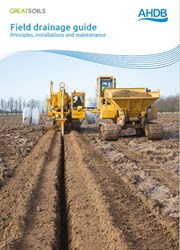- Home
- Knowledge library
- An introduction to field drainage
An introduction to field drainage
Discover how, why, and when field drainage is important, as well as best practice for installation, maintenance and repairs.
What is field drainage?
Well-maintained field drainage systems help remove excess soil water (held in the upper soil horizons) and can be used to control a water table.
A good drainage system will reduce the risk of detrimental waterlogging to acceptable levels and help return soils to field capacity after wet weather.
Did you know?
Around 6.4 million hectares of agricultural land in England and Wales is drained with piped systems.
Costs and benefits of field drainage
The benefits of field drainage to the farm business can be substantial. In some years, drainage can make the difference between having a crop to harvest and complete crop loss; or whether the land can be accessed to harvest the crop.
Benefits of field drainage to the farm business
How to map field drainage systems
Fields may already have some form of drainage. Find out how to identify any system present with a drainage plan or field observations.
How to map field drainage systems
The signs of good and bad field drainage
While some signs of poor drainage may be easy to spot, waterlogging can also be hidden so it’s important to know how to identify when drainage is required.
The signs of good and bad field drainage
When to invest in field drainage
The scale and intensity of the drainage system should match the requirement to protect cropped land from waterlogging.
When to invest in field drainage
Environmental impact assessments
It is important to conduct an environmental assessment before installing or carrying out maintenance on field drainage systems.
Conducting an environmental impact assessment
The importance of soil health
Maintaining good soil health may help you avoid costly capital investments. If soil examination identifies compacted layers that impede water movement, take remedial action to remove them before considering drainage investment.
Mole drains
Mole drains are unlined channels that improve natural drainage, particularly in heavy or calcareous subsoils. Find out how to use them as part of a field's drainage system.
Maintenance and repairs
If ditches, outfalls and pipes are not kept clear, the field drainage system will not function effectively and may require more expensive maintenance or premature renewal.
Renewal and installation
From soil type to outfall availability, there are many technical factors to consider when designing a new drainage system.
Drainage designers, contractors and the law
It is important to work with specialists and experts to assess whether to maintain an existing system or create a new one, and to consider any legal issues.
Designers, contractors and the law
Assessing the benefits of drainage
A trial at Strategic Cereal Farm North is comparing the crop-performance impact of a new drainage system on heavy soils.
On-farm trials at Strategic Cereal Farm North (2022–2028)
Glossary of terms
Numerous specialist terms are used in field drainage. Discover some of the most used words, alongside a brief definition.
Available in print
Soil management videos
Topics:
Sectors:
Tags:


